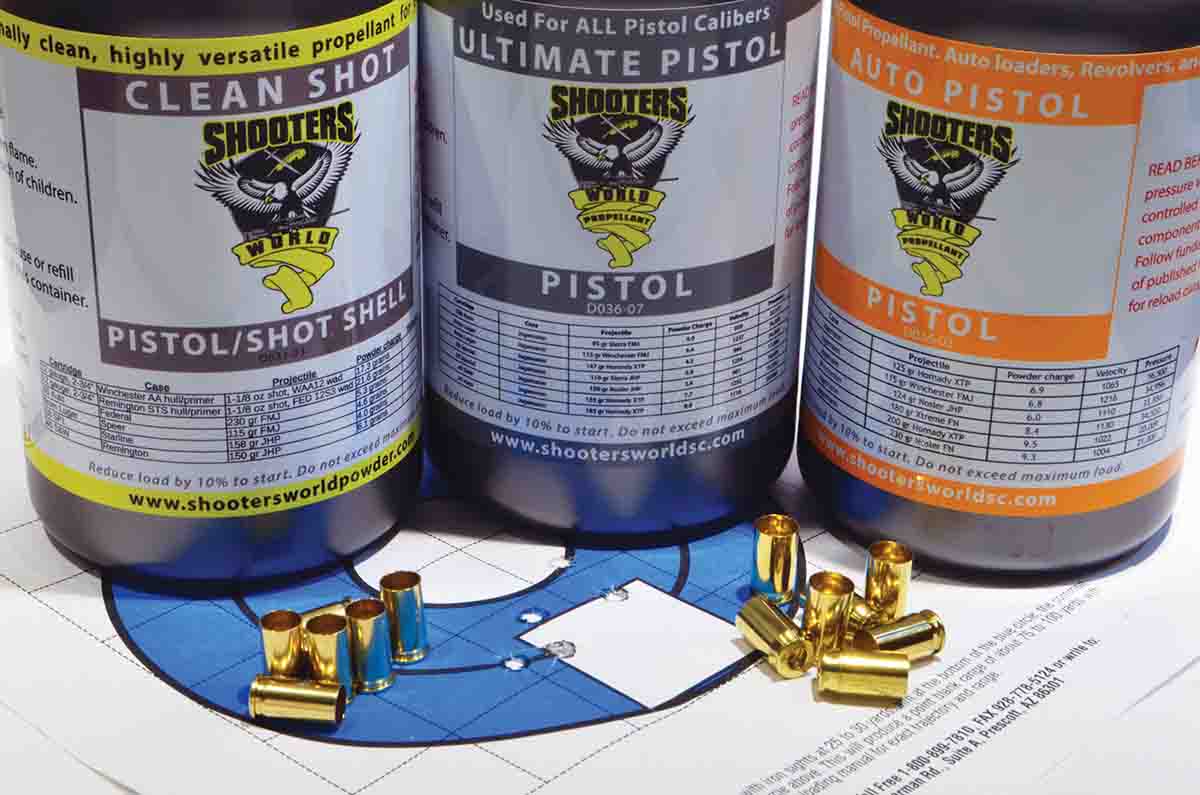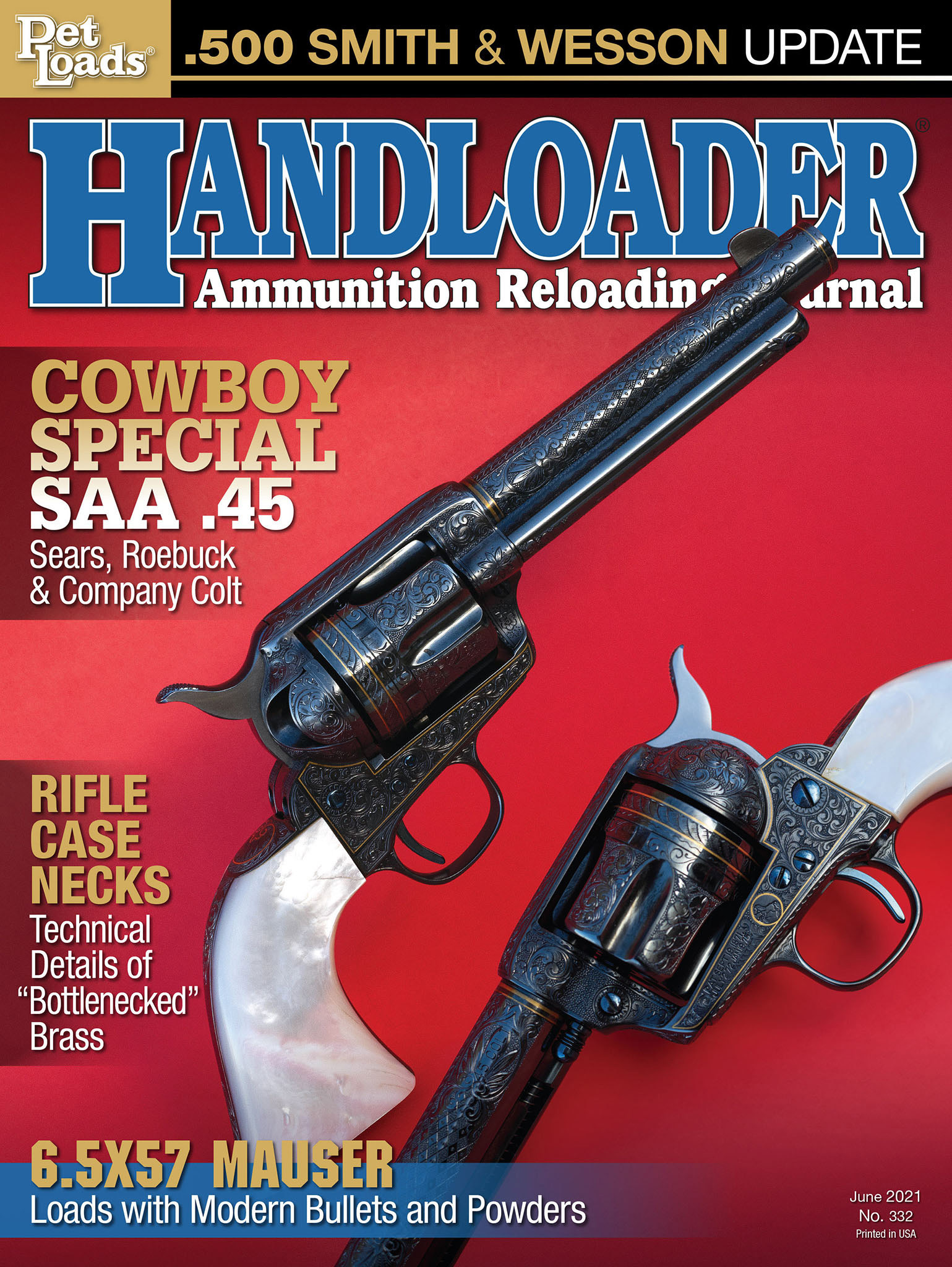In Range
It's a Shooter's World
column By: Terry Wieland | June, 21

“Testing a couple of new powders,” I replied. “Shooting .32 Auto and .380.”
“What were the powders?” he asked, but without waiting for an answer, continued “I just use Bullseye and Unique. About the only pistol powders you need, really.”
There, in an unexpected, unsolicited nutshell is the problem facing any powder manufacturer, importer or supplier in this country: If they want to sell pistol powder, they have to come up with something that is notably hotter, cheaper, more economical, more accurate, easier to meter or cleaner than Bullseye, or forget it. Not that Bullseye is perfect. It’s not the cleanest, either to burn or to handle, but economical to use? Consider this: An old friend of mine had a 20-pound keg of Bullseye he bought in the 1960s, and was still dipping into it when I met him in 2002. Plus, there was a bit left when he was admitted to a nursing home a decade later.
A typical charge of Bullseye for the .38 Special is 3.5 grains, which means you get 2,000 rounds from a pound of powder. At that rate, his 20-pound keg would have given Dick 40,000 rounds. Bullseye has the additional advantage that it meters very consistently, so it’s quick and easy to load a lot of rounds.
So, my friend asked, “How are these new ones better?” Good question.
The powders in question were three from Shooters World: Auto Pistol, Ultimate Pistol and Clean Shot. Over the past few months, I’d worked with the .32 ACP and .380 for a couple of Handloader articles, but was unable to obtain any of the Shooters World powders in time to include them. This is intended to rectify that.
Shooters World was created by Ned and Karen Gerard in 2014, and they were joined by a third partner, ballistician Ken Johnson, later that year. They import the Explosia line of powders from the Czech Republic. Some of these are marketed to reloaders in Europe under the brand name Lovex. Shooters World is the exclusive importer of Explosia powders in the U.S. As of right now, it’s a complete line, including rifle, pistol and shotgun powders.
As with most importers of anything from Europe, the last 12 months have been chaotic, combining production shortages and shipping bottlenecks at that end with unprecedented demand at this end. As soon as some powder arrived from Czechia, it was repackaged and out the door – hence the difficulty in getting a few pounds for testing. It was, however, worth waiting for.
These days, it seems that every maker of bullets or powders offers its own loading manual. For powder makers especially, this makes eminent sense. No handloader who values either his guns or his personal parts (eyes, fingers, that sort of thing) is going to start loading with a powder unless he has reliable data to guide him. Waiting for another manufacturer to include your product in its manual, which may or may not happen, and even then, may not appear for a year or more, and finally with no guarantee everyone will buy it, is not exactly a formula for promotional success.
Shooters World publishes its own manual, available free of charge online, which can be downloaded as a PDF or stored on your computer. This means you can take it with you to the range. It also means it can be updated or expanded relatively quickly as new data is developed. As has become common practice, Shooters World also prints basic loads for the most common calibers on the container labels themselves.
The online manual offered data for the .380 ACP, but nothing for .32 ACP. Ken Johnson suggested that, since Ultimate Pistol is very close in burning rate to Hodgdon’s CFE Pistol, I start with comparable charges at the low end and work up. Accordingly, I started at 2.5 grains, then increased it to 2.75 and 3.00 grains, all using the 71-grain bullet that’s standard in the .32 ACP.
For the .380, I tried Ultimate Pistol as well as Auto Pistol and Clean Shot, as shown in the accompanying table.
My overall impression of all three powders is that they are economical to use, requiring tiny charges for these cartridges, and are very easy to handle. All three (especially Clean Shot) meter like a dream. Because I was going to be working with such small powder charges the past few months, I obtained one of Redding’s new measures especially designed for accurate metering of small charges. As an experiment, after it was locked in to throw 3.0 grains of Clean Shot, I measured 10 loads in a row. Each charge weighed exactly 3.0 grains.
My test guns were a S&W Shield EZ (.380) and a Beretta Model 81 (.32 ACP). Shooters World does not include length of test barrels with its data (at least, not that I could find), but with the Smith’s 3.5-inch barrel and the Beretta’s 3.75-inch barrel, the results were remarkably close to Shooters World’s projected velocities.
For example, with 3.0 grains of Clean Shot and a 95-grain bullet, the projected velocity is 932 fps, and I chronographed it at 954 fps. With Ultimate Pistol, instead of the expected 939 fps, I measured 924.
With the .32 ACP, Ken suggested I should expect to get 825 fps with the starting load of 2.5 grains of Ultimate Pistol, and I measured it at 850. Such consistency, combined with the low extreme spreads (see table) is unusual in small-caliber pistols with short barrels.
With pistols like these, which have sights that are either fixed in place or difficult and inexact to adjust, group placement is just as important – if not more so – than group size, especially in a self-defense gun. The group sizes are shown in the table. What is not shown is the fact that, regardless of the load, they all printed in the same place on the target – an inch or two high at 10 yards, but with perfect windage. In other words, just about where you would set your sights were it possible to do so.
The other major concern with self-defense guns is functioning, and through the course of the shooting test, I had not a single failure to feed, extract or eject.
Beyond that, when a shooting test goes this smoothly, what can one say? In answer to my friend who is such a fan of Bullseye, get yourself some Clean Shot. You’ll like it.



.jpg)